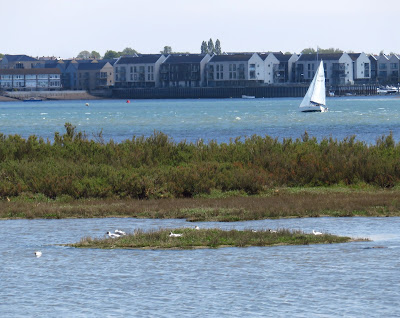Half a dozen small white butterflies were also noted along the field edges, as were large white, peacock, ten small heaths, common blue, holly blue and speckled woods too.
Birds noted included the singing Cetti's warbler, reed bunting, yellowhammer, two common buzzards, two great spotted woodpeckers, three long-tailed tit families and a yellow wagtail.
On Wednesday 29th two little terns were in the Strood Channel and another two near the Hard, also two common terns and a pair of Mediterranean gulls along the channel. The regular common buzzard was over the Strood fields, while from the seawall one sedge warbler was singing, 3 yellow wagtails were noted while a pair of house martins was gathering mud from the Hard.
At East Mersea a cuckoo was seen by Andy Field perched by the country park pond, also six pochard on the pond. Six reed warblers, Cetti's warbler were heard singing at the park and a pair of red-legged partridge were near Bromans Farm.
David Bullock reports from East Mersea the cuckoo calling most mornings at 5am and also regular red squirrel visits including possible youngsters to his garden near the turning for the Oyster Fishery.
A female marsh harrier flew across the Strood fields heading towards the West Mersea Hard on Tuesday 28th, also common buzzard over the fields too.
A cuckoo perched on some distant wires near the Strood seawall on Tuesday, with a second bird heard calling from Ray Island. Two sedge warblers were heard singing in the dyke, corn bunting singing, and a flock of 18 linnets, while a small group of 50 swifts headed north-west off the island with about 30 still circling over the West Mersea houses.
Along the Strood channel on Tuesday were 3 little terns and 2 common terns with the only waders noted being six oystercatchers.
A brown argus butterfly was a surprise visitor to the Firs Chase garden on Tuesday 28th, seen resting on a window late afternoon.
Two common seals were seen from Maydays farm on Monday 27th resting on one of the floating pontoons in the Pyefleet Channel. Both slipped back in the water when a kayak appeared on the scene. An oystercatcher which seemed to be nesting in one of the blue plastic boxes, seemed anxious when the seals came aboard.
Also on the Pyefleet channel were four great crested grebes, 12 whimbrel and 14 shelduck.
The faint chorus of the croaking marsh frogs carried in the breeze across the Pyefleet from the ditches and dykes on Langenhoe marsh.
From the Maydays seawall on Monday were seen a pair of marsh harriers on Reeveshall, two common buzzards, singing sedge warbler, 4 reed warblers, 3 reed buntings, male corn bunting, four lapwing, yellow wagtail, yellowhammer and a pair of red-legged partridge, while around the farmhouse were 30+ house martins.
On Sunday 26th eight swifts, 5 swallows, 2 house martins and a calling cuckoo were noted from the Firs Chase garden.
























































